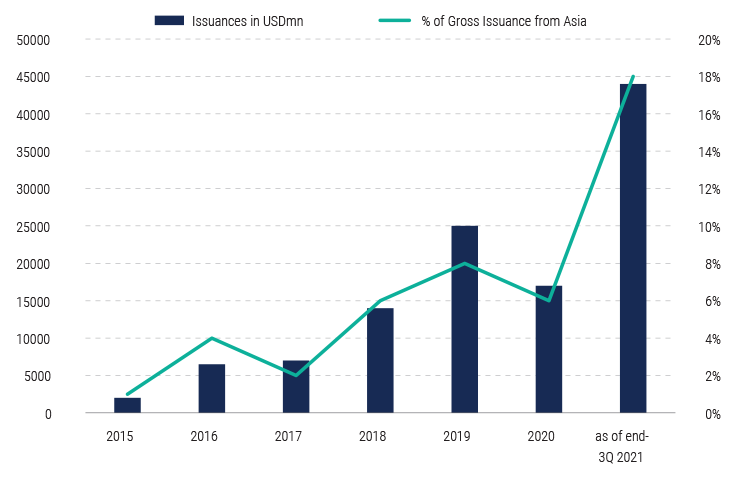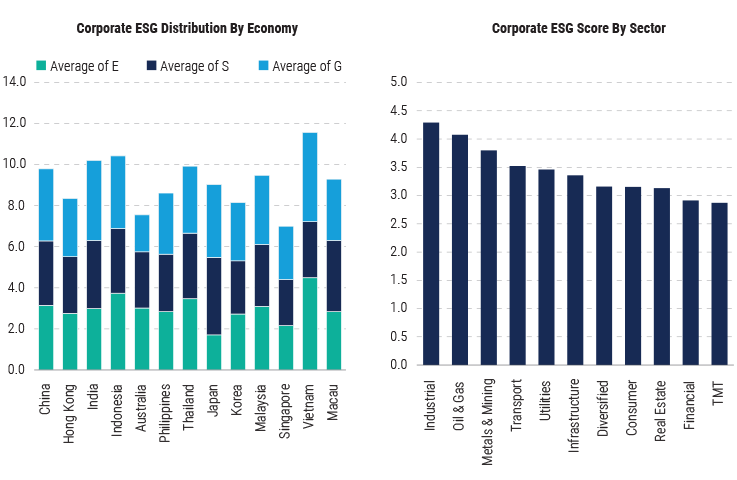Asia occupies a unique spot at the intersection of sustainability and finance. It is home to 60% of the world’s population, two of the world’s top three energy-consuming countries, and a growing trillion-dollar credit market.1 At the same time, 99 of the 100 riskiest cities for environmental and climate-related threats are in Asia.2 In recent years, the region’s largest economies have announced timelines toward carbon neutrality, measures to reduce greenhouse gas emissions, and investments in cleaner energy sources, electric vehicles, and other green technologies in a bid to stem climate change.
The United Nations estimates that Asia-Pacific requires an additional investment of US$1.5 trillion annually to meet the Sustainable Development Goals by 2030.3 Reflecting the financing gap and the regulatory push, Asia saw a surge in issuance of environmental, social, and governance (ESG)-related bonds in 2021. These bonds offer opportunities for international investors to gain exposure to a new potential alpha source in Asia fixed income. When the Hong Kong government issued US$2.5 billion in green bonds in 2021, European and US investors cornered a third of the total issuance.4
2021: A Record Year for Green, Social, Sustainability, and Sustainability-Linked Bond Issuance in Asia

This investment environment presents exciting new frontiers. On one hand, capital dedicated toward ESG investments is growing; on the other, opportunities for capital appreciation increase as companies bridge ESG gaps. For now, it is a case of large amounts of money chasing few assets, which could lead to disappointment if investors are not carefully vetting the ESG processes of the underlying businesses they’re investing in and the securities selectors they’re engaged with.
The integration of ESG factors into investment processes is still relatively new in Asia compared to the US and Europe, given a limited understanding of its benefits and a relative lack of commercial motivation, among other reasons. Yet our experience investing in Asian fixed income for nearly two decades has shown that ESG factors have a measurable impact on outcomes in areas such as credit quality, defaults, and spreads. In times of financial stress, like today, investing with an ESG lens can help fortify portfolios through heightened risk management – and active investing using local expertise and an on-the-ground presence offers the added advantage of a more nuanced approach to identifying risks and opportunities.
Here we provide practical insights into how ESG influences our Asia fixed income investment decisions and our views of some emerging trends in the region.
Environmental: driven by regulation and investor demand
Regulations and institutional investor demand are the main drivers of environmental considerations in Asia. In certain sectors (including energy, metals and mining, and utilities, among others), environmental factors play an increasingly critical role due to growing awareness of climate change and sustainable financing. For example, the Asian palm oil industry, which produces the bulk of global supply, has been subject to scrutiny for its alleged role in deforestation and destruction of wildlife, and in recent years, large institutional investors have divested their holdings in the sector. Bonds of Asian palm oil companies have seen periods of volatility following negative news. In 2018, we passed on a maiden bond offering of an Asian palm oil company because of its noncompliance with industry sustainability standards. The bond has been trading at distressed levels since 2019.
Staying on top of environmental regulatory changes is key in Asia. In recent years, the Chinese government has put greater emphasis on sustainable growth, including imposing stricter environmental regulations. Companies’ noncompliance could be costly and pose an investment risk. In addition, Asia’s pivot to renewable energy has created opportunities in fixed income. We participated in an issue by one of the largest pure-play renewable energy generation platforms in India. With renewable energy a key priority for the Indian government, supportive regulatory measures in recent years have been positive for the bonds. Several international long-term investors also became shareholders, providing capital to support growth.
Social: a growing focus
Social factors typically have a small, short-term impact on businesses; however, social policies have taken greater priority in some governments’ agendas. China’s pivot toward “common prosperity” policies in 2021 underscored the focus on sustainable and fair business practices. While the policies have upturned the after-school tutoring and online gaming industries, as well as the economically important property sector, over the long term, sectors and businesses aligned with these new policies are expected to benefit from opportunities.
Even before these new policies, we saw how a strong social focus can translate to investment opportunities. For instance, we invested in one of the largest urban rail systems in China, which has an estimated average daily ridership of 10 million. Ticket prices are set low, with the company putting greater emphasis on its mandate of providing a public good. While we tend not to favor Chinese local government financing vehicles given their sometimes weak financial profiles, this company had a high ESG score. It maintains a strong safety record and a good relationship with its workforce. The bonds’ spread remains stable compared to top-tier state-owned enterprises.
More recently, amid the Covid-19 outbreak, a privately owned Chinese express delivery company put considerable effort into ensuring employees’ health and safety at its own expense, such as by providing sanitation facilities, masks, and quarantine spaces. It also demonstrated greater social impact by transporting essential goods to the healthcare sector and to help support people’s livelihoods. Despite broader disruptions in the logistics industry, the company’s delivery capability remained strong because of its extensive, self-owned network. The market appears to recognize this: The spread of the company’s bonds continues to be close to those of similarly rated state-owned enterprises.
The private sector is also beginning to tap the social bonds market. In November 2021, a Thai food company launched the first social bond by a nonfinancial corporate issuer under the Association of Southeast Asian Nations (ASEAN) social bond standards. Meanwhile, foreign entities are now allowed to issue yuan-denominated bonds for social responsibility and sustainability projects in China’s large onshore bond market.
Governance: gaining a higher profile
The governance element continues to be a major focus in Asia, mainly because of the large number of issuers that are government-owned, family-owned, or part of intricate cross-shareholdings. We believe a proper assessment of corporate governance is critical in Asian fixed income investing. For example, the ownership structure can have direct implications on default risk. We encountered a case where an issuer marketed itself as a “state-owned enterprise” during a bond roadshow, but then declined to discuss details of the formation of its board of directors. State-owned enterprises may offer creditors added confidence in the form of a potential backstop or an implicit guarantee by the parent entity in the event of financial difficulties or default. This also allows the issuer to price bonds at a tighter spread. In this case, however, we found that the issuer’s shareholding structure was complex and determined that the company does not meet the definition of a state-owned firm. Our analysis led us to pass on the bonds, which later defaulted.
Moreover, governance-related lapses have cost bondholders in Asia billions of dollars over the years. One notable case in the past decade involved a Hong Kong-listed Chinese timber company, whose CEO and controlling shareholder was found to have embezzled millions from the company. Its management also admitted to fabricating the company’s assets and revenues. The company defaulted three months after it issued a US dollar bond.
ESG risk scoring: ever-more critical for security selection
The examples above illustrate the need for a more deliberate ESG analysis, which we view as critical for robust risk management. Our global emerging market (EM) fixed income team’s ESG process generates proprietary quantitative risk scores at the country, sector, and issuer levels (the higher the score, the higher the ESG risk), based on nine categories. The integration of ESG scores into our common global credit analysis platform and portfolio management tools allows the team to analyze ESG risk over time. Analyst input also plays an important role in accurately assessing these ESG risks, and ultimately in promoting better security selection. More than one analyst will cover a sector, adding further rigor to the process. The chart below shows the disparity in ESG scores by market and sector, reflecting the different stages of ESG development in Asia.
Our ESG Risk Scores Vary Significantly by Sector and Market
(Lower score = lower assessment of risk)

Asia’s evolving ESG landscape
Asia is narrowing the gap with other regions in ESG. Market regulators and securities exchanges have established a variety of requirements for ESG disclosures for listed companies. China is now one of the largest green bond markets in the world, while Hong Kong issued the first long-dated sovereign green bond in 2021, with a 30-year tenor, which is viewed as key in building a comprehensive benchmark curve for future issuers in Asia.
Yet challenges remain. For now, we have yet to see a consistent green/ESG bond premium in Asia green bonds. Sustainability-linked bond issuances are a positive development, but issuers often have below-average ESG characteristics and have set out sustainability targets, which, if not met, could result in a coupon step-up at a specific year (usually close to the final year). While the bonds sound good on paper, in our view most issuers thus far have either unambitious targets or negligible, non-punitive coupon step-up provisions, which offer limited additional incentive to work toward achieving those targets. We believe greater scrutiny from the investor community will be needed to make the targets and compensation more meaningful.
Investors also still face some hurdles in Asia, including the alignment of domestic “green” definitions with international principles, limited diversity of the types and sectors of issuers, and limitations related to transparency and credit ratings.
That said, we expect growing investor interest in sustainable investing in Asia will drive greater focus on ESG for issuers, investors, and asset managers, boosting the case for alpha from ESG in Asia fixed income.
Footnotes
1 Sources: Population: UN Department of Economic and Social Affairs, World Population Prospects 2019; Energy: BP Statistical Review of World Energy 2021; Market Size: JP Morgan, PineBridge as of 30 September 2021.
2 Verisk Maplecroft, “Asian cities in eye of environmental storm – global ranking,” May 2021. See: https://www.maplecroft.com/insights/analysis/asian-cities-in-eye-of-environmental-storm-global-ranking/
3 UNESCAP, 2019 https://www.unescap.org/sites/default/d8files/knowledge-products/Economic_Social_Survey%202019.pdf
4 Hong Kong Monetary Authority, 27 January 2021. See: https://www.hkma.gov.hk/eng/news-and-media/press-releases/2021/01/20210127-3/

